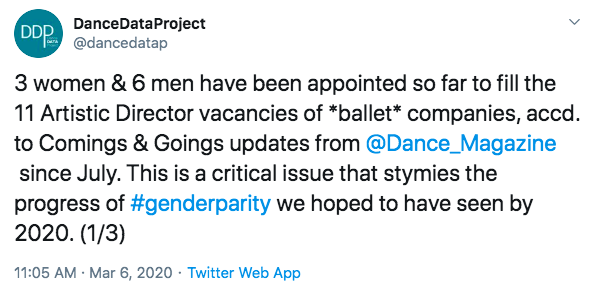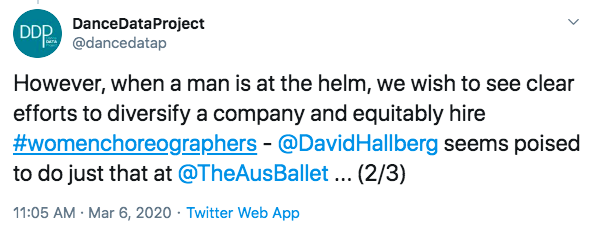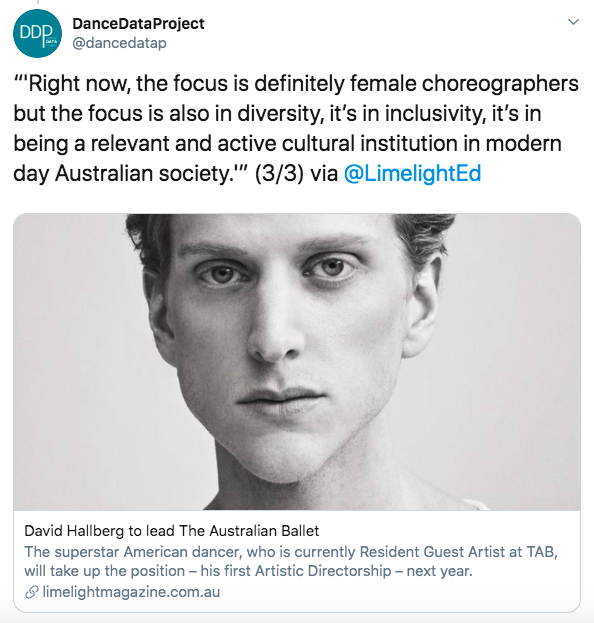DDP Talks To
"The Devil Ties My Tongue" by Amy Seiwert performed for the SKETCH Series, 2013. Photo by David DeSilva. Courtesy of Amy Seiwert's Imagery
January 22nd: Opera America Grants, March 3rd: Dance | NYC: Dance Workforce Resilience (DWR) Fund, March 31st: SIA Foundation Grants
×
"The Devil Ties My Tongue" by Amy Seiwert performed for the SKETCH Series, 2013. Photo by David DeSilva. Courtesy of Amy Seiwert's Imagery
DDP will cover stories from the corporate, for profit world regarding issues surrounding pay equity and transparency where relevant, such as other industries with low representation of women: tech, the sciences, venture capital, the entertainment industry, etc. to examine parallels between these male dominated spheres where informal hiring and word of mouth is the norm.
From Alexandra Ramirez, Brand Marketing Director
| Yup. Seriously nothing. ICYMI: Earlier this week, Women’s History Month came to the most anticlimactic end in, well, history. And Equal Pay Day became a blip on our own, and the world’s, radar. As CEO Sallie Krawcheck wrote earlier this week, it’s hard to think about fighting for equal pay when people are fighting to make ends meet. Research shows, however, that people with less privilege — women and particularly women of color and trans women — are more likely to be negatively impacted in a pandemic. Similar to the gender-neutral approach to investing that has held women+ back for so long, there is a gender-neutral approach to pandemics. And while policymakers will say there are “bigger issues,” the reality is the gender disparities that existed before COVID-19 have only been amplified.So what’s a financial feminist to do? To be honest, I’m struggling to answer that question right now, too. I’m holding onto these four truths as I head into the weekend: 1) The fight for gender equality affects millions of women and girls and we must keep it in focus, 2) women supporting women is more important than ever, 3) we cannot do this without our allies and people of privilege using their power to prioritize gender equality, and 4) nothing bad happens when women have more money. |
Read more articles from Ellevest here.
By Alex Marshall
24 March 2020
LONDON — The British choreographer Liam Scarlett on Monday left his position as the Royal Ballet’s artist-in-residence, after an investigation into accusations of sexual misconduct with dance students.
Mr. Scarlett will “no longer work with, or for, the Royal Ballet,” the company said in a statement, which added that a seven-month, independent investigation the company commissioned “found there were no matters to pursue in relation to alleged contact with students of the Royal Ballet School.”
A spokesman for the Royal Ballet said the company would not comment further on the announcement. Mr. Scarlett did not immediately answer an email requesting his response.
Mr. Scarlett, once heralded as a “choreographic wonder boy of British ballet” by The New York Times, has created works for dance companies worldwide, including the American Ballet Theater. This month, the Royal Ballet was forced to end the sold-out run of his “Swan Lake” at the Royal Opera House after the coronavirus pandemic shut down the venue.
Read the full article here.
Last year, an arbitrator ordered New York City Ballet to reinstate two male dancers it had fired after they were accused of sharing sexually explicit photos of female dancers.
By Kathleen McGuire
13 March 2020
Kathryn Morgan is on a mission to change the dance field. The Miami City Ballet soloist and March Dance Magazine cover star appeared on the “Today” Show on February 27 where she openly discussed the challenges of body image and mental health in dance.
Two days later, Morgan took to her own YouTube channel to dig deeper on the subject. She shared with her followers that she had been recently removed from performing Firebird because of her body. We caught up with Morgan to learn more.
I had that incredible experience of being able to tell my story on the “Today” Show and one of the things I really asked to talk about was body image and the mental side of ballet because I have dealt with it and I still deal with it. The problem is that the “Today” Show interview is only three minutes and I just felt that I needed to expand upon it because I did not get to say everything that needs to be said.
When I sat down to film it I didn’t know I was going to get that emotional and I didn’t know exactly what I was going to say, but I started talking and it all just came out. I was like, This is the time, no one is talking about this and we need to be talking about it.
Read the full article here.
By Lizzie Green
11 March 2020
What does a typical ballet duet look like? Perhaps it is a depiction of a heteronormative couple, where the woman wears pointe shoes and is spun, contorted, and hurled through the air at the mercy of her male counterpart. But in choreographer Mari Meade’s work, “paired reflections,” she strives to challenge this prototype.
Originally choreographed for dancers at New York City Ballet as part of the fall 2018 New York Choreographic Institute, Meade will stage “paired reflections” on dancers from Columbia Repertory Ballet, a student group that provides advanced dancers with the opportunity to perform established repertoire in ballet and contemporary dance.
Meade was born in California and raised outside of New Orleans. In 2009, she moved to New York to found her own contemporary company, Mari Meade Dance Collective. She has since traveled the world showcasing her work and has held a number of prestigious fellowships such as the Kenan Fellowship at Clark Theatre at Lincoln Center, as well as residencies around the country. She heard about the opportunity to work with CRB through “the grapevine” from other New York artists.
Read the full article here.
By Heidi Nichols Haddad
08 March 2020
On International Women’s Day, how is the U.S. doing on women’s rights? That question could be answered in many ways, of course, pointing to anything from Harvey Weinstein’s recent conviction for sexual assault to how a diverse Democratic field of presidential candidates narrowed to a race between two white men. But here let’s look at a different, less celebrated arena: local governments. In the past several years, Honolulu, Cincinnati, Pittsburgh, San Jose, Berkeley and the counties of Miami-Dade and Santa Clara have put binding gender equality laws on the books.
These local laws are a direct answer to federal inaction on women’s rights. The Equal Rights Amendment (ERA), which would constitutionally enshrine equal rights regardless of sex, failed to win the necessary 38 state ratifications by the legislation’s 1982 expiration date.
Further, the United States is one of only six United Nations member states — and the only industrialized democracy — that hasn’t joined the U.N. Convention on the Elimination of All Forms of Discrimination Against Women (CEDAW). The other non-signatory countries are Iran, Sudan, Somalia, Palau and Tonga.
Dubbed the “international women’s bill of rights,” CEDAW represents the most comprehensive global consensus on promoting and protecting women’s rights and the associated obligations of both governments and private actors. President Jimmy Carter signed CEDAW in 1980. The Senate held hearings on CEDAW in 1988, 1990, 1994, 2002 and 2010, and twice reported favorably on it, but the treaty never reached the Senate floor for a vote.
U.S. policymakers have generally agreed with CEDAW’s goal of eliminating gender discrimination. But they clash, mostly along party lines, over its likely effect on the private lives of Americans. During the 2002 hearing on CEDAW, Republican Sens. Mike Enzi and Sam Brownback questioned why the U.S. would join a treaty that did not reduce women’s oppression in Afghanistan, Saudi Arabia and North Korea. The activist groups Concerned Women for America and the National Right to Life Committee have strongly mobilized against CEDAW; they see it as undermining traditional family roles and implicitly endorsing abortion.
Read the full article online here.
The Australian Ballet announced this week that famed American danseur David Hallberg would be the company’s next Artistic Director, effective January 2021.
Read the announcement here.
See DDP’s tweets on the subject in the shots below:



By Jo Litson
3 March 2020
David Hallberg has been appointed as the next Artistic Director of The Australian Ballet. The American-born superstar dancer, who is a Principal with both American Ballet Theatre and The Bolshoi Ballet, as well as a Principal Guest Artist with The Royal Ballet, knows The Australian Ballet well. He is currently a Resident Guest Artist with the Company, and in 2015/16 undertook an intense 14-month rehabilitation program with TAB’s medical team, who helped him recover from a debilitating ankle injury.
It will be the first time that Hallberg has run a ballet company as Artistic Director. Speaking to Limelight last year, prior to performing at the Sydney Opera House in Pure Dance with Natalia Osipova, he said that he would like to run a company one day. “[It] certainly feels like that’s the direction I’m headed in. I do feel a very inspired inclination to nurture the younger generation, and to really nurture audiences as well from the repertoire that I’ve witnessed throughout the world. I do feel like I’ve been fortunate to gain a lot of experience in Russia, in England, in New York, Japan and all over the world,” he said. “There’s going to come a time where the spotlight goes off me and goes on to other dancers, and I really would like to reward them with the experience that I’ve garnered.”
He agrees that more needs to be done to increase the number of women choreographers in ballet.
That is definitely important, but what else is important is the conversation that The Australian Ballet has with this age, and being relevant in the community, and really trying to ask the question of what is the greater responsibility to the greater community by The Australian Ballet. Right now, the focus is definitely female choreographers but the focus is also in diversity, it’s in inclusivity, it’s in being a relevant and active cultural institution in modern day Australian society.
Read the full article on Limelight.
NEWS that a Russian will become the new artistic director of Ballet Philippines (BP), replacing National Artist Alice Reyes after her term ends in March, has sparked a social media uproar in cultural circles, inspiring a Change.org petition and a demand that the appointment be rescinded.
“We the Ballet Philippines community, dance artists, alumni, and artistic team, are united in the belief that Ballet Philippines is Filipino, for the Filipinos, and by Filipinos,” declares a statement addressed “To the Ballet Philippines Foundation, Inc. Board of Trustees,” which has been spread through social media with the hashtag #WeAreBalletPhilippines.
“We call on the Board to revoke the appointment of the foreign national Mr. Mikhail Martynyuk as Artistic Director,” it continues.
There is also a Change.org petition asking the BP Board to “to rescind or revise the contract offered to a Russian artist from a position as Artistic Director to another honored artist position in Ballet Philippines and to keep the position of Artistic Director Filipino.” It has garnered 2,558 signatures as of posting.
Read the full article online here.
By Julia Jacobs
19 February 2020
A half-hour before the start of “West Side Story,” two dozen protesters outside the Broadway Theater inched closer to the production’s turf.
Blocked by parked cars from their usual spot in the street, they instead occupied the sidewalk alongside ticket holders, many of whom looked quizzically at the demonstrators’ signs and fliers.
“Hey hey, ho ho, Ramasar has got to go,” they chanted, as they have on several other nights outside the show, referring to Amar Ramasar, a “West Side Story” cast member who was fired, and then reinstated, at New York City Ballet after sending sexually explicit photos of his girlfriend to another dancer.
The protesters object to his casting in the show, in which he is playing Bernardo, the leader of the Sharks street gang, a high-profile role that involves a lot of strutting across the stage with an air of machismo, and, at times, lust. Mr. Ramasar’s critics assert that his inclusion in the cast is inappropriate given his previous behavior.
Read the full article in the New York Times.
By Alex Marshall
20 February 2020
Some of the dance world’s biggest names threatened to withdraw work from the repertoire of the Lyon Opera Ballet — a major French company — this week unless it reinstated its former artistic director.
“This is with a heavy heart,” they wrote in an open letter published in Libération, a major newspaper in France. But, they added, they saw “no other solutions.”
Yorgos Loukos, the Lyon company’s artistic director since 1991, was fired this month after a French court found him guilty of discriminating against a dancer. Mr. Loukos had refused to give the dancer a contract when she returned from maternity leave.
The Lyon Opera Ballet’s decision to fire him was “incomprehensible and arbitrary,” said the letter, which called on the French government to intervene.
The letter — in which stars appeared to hold a company to ransom — contained the signatures of around 100 people, including Benjamin Millepied, William Forsythe, and the European choreographers Jiri Kylian and Mats Ek. Sylvie Guillem, the French ballet star who retired in 2015, was listed as a signatory, as was the actress Isabelle Huppert.
But when The New York Times contacted some of the letter’s signees for comment, several disavowed it.
“I was asked to sign, but declined, because the letter spoke to internal matters of the theater of which I have no direct experience or knowledge, and I do not agree with the coercive tactics,” Mr. Forsythe said in an email.
Read the full article in the New York Times.
Reach out to us to learn more about our mission.
"The Devil Ties My Tongue" by Amy Seiwert performed for the SKETCH Series, 2013. Photo by David DeSilva. Courtesy of Amy Seiwert's Imagery
